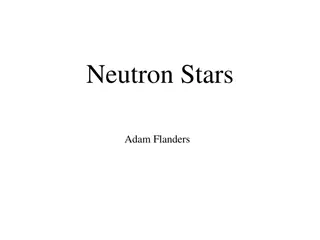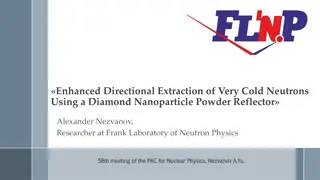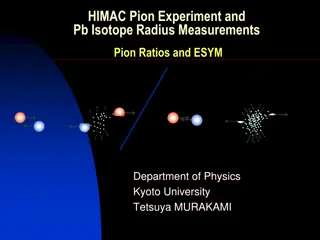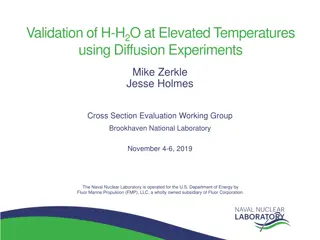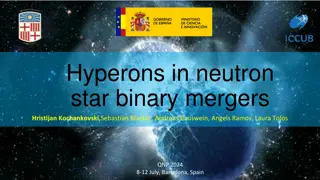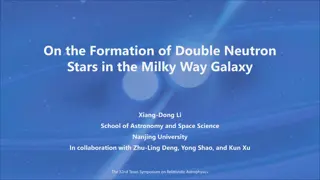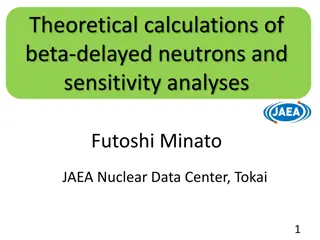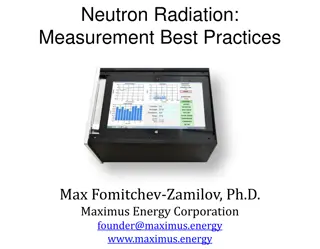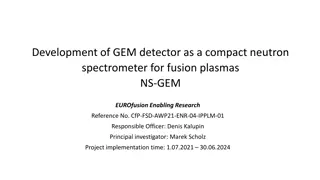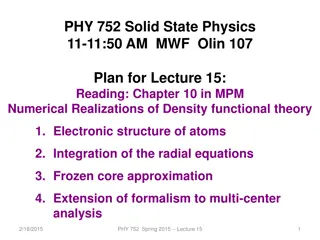Exploring Neutron Star Equations of State in Theoretical Physics
Study of gravity at high energy density using General Relativity, testing Einstein's equations, constructing Equations of State (EoS) from hadron inputs, and examining theories beyond GR. Focus on constraints from astrophysical observables and determining uncertainties in employed EoS.
Download Presentation

Please find below an Image/Link to download the presentation.
The content on the website is provided AS IS for your information and personal use only. It may not be sold, licensed, or shared on other websites without obtaining consent from the author. Download presentation by click this link. If you encounter any issues during the download, it is possible that the publisher has removed the file from their server.
E N D
Presentation Transcript
Neutron Star Equations of Neutron Star Equations of State State Eva Lope Oter mariaevl@ucm.es Theoretical Physics Department, Universidad Complutense de Madrid QNP2024 Barcelona, July 9, Spain Cr dito:ESO/NASA, ESA and the Hubble Heritage Team (STScI/AURA)/F. Vogt et al
Motivation 1. We aim to study how gravity works at high energy density General Relativity (GR) requires further testing: Einstein s equations have not been exhaustively constrained at such high : Testing the theory of gravity in the presence of matter requires sizeable T , so prior knowledge of EoS is needed. Several constraints on current EoS coming from observables obtained within GR. Our goal is to construct EoS from hadron inputs alone and to test GR and theories beyond GR 10/09/2024 2
Motivations 1. We aim to study how gravity works at high energy density General Relativity (GR) requires further testing: Einstein s equations have not been exhaustively constrained at such high : Testing the theory of gravity in the presence of matter requires sizeable T , so prior knowledge of EoS is needed. Several constraints on current EoS coming from observables obtained within GR. Our goal is to construct EoS from hadron inputs alone and to test GR and theories beyond GR 2. Another aim is to answer the question: How many first-order phase transitions can a NS EoS admit fulfilling constraints from astrophysical observables? 10/09/2024 3
Motivations 1. We aim to study how gravity works at high energy density General Relativity (GR) requires further testing: Einstein s equations have not been exhaustively constrained at such high : Testing the theory of gravity in the presence of matter requires sizeable T , so prior knowledge of EoS is needed. Several constraints on current EoS coming from observables obtained within GR. Our goal is to construct EoS from hadron inputs alone and to test GR and theories beyond GR 2. Another aim is to answer the question: How many first-order phase transitions can a NS EoS admit fulfilling constraints from astrophysical observables? 3. If we want to build exotic physics in General Relativity and beyond, we need to determine the systematic uncertainties at the employed EoS. 10/09/2024 4
nEoS for cold matter n 40 n 40 ns s P( ) CRUST INNER CORE OUTER CORE OUTER CORE Uniform Neutron Matter ? ? CRUST INNER CORE n 2 n 2 ns s Maximum central density R 1 Km R 11-13 Km Generate EoS from hadronic theory and by fundamental principles 10/09/2024 5
EoS from hadron physics and fundamental principles B = 450- 600 MeV EFT: hadron matter (n 2 n 2 ns s) B = 2.6 GeV Q1 ( B, ,P1) Q2 ( B, ,P2) pQCD: quark matter n 40 40 n ns s A. Kurkela et al., Phys.Rev.D81 (2010) 105021 E.S. Fraga et al. Eur.Phys.J.A 52 (2016) 3, 49 10/09/2024 6
EoS from hadron physics and fundamental principles CRUST n 40 n 40 ns s INNER CORE OUTER CORE P( B) OUTER CORE Neutron Matter ? ? CRUST INNER CORE n 2 n 2 ns s E/A(n) Maximun central density Stability Causality Thermodynamic consistency Generate EoS from hadronic theory and by fundamental principles 10/09/2024 7
Interpolation: Allowable region by stability and causality http://teorica.fis.ucm.es/nEoS ??2=?? ??2=?? ?? 0 1. Stability ? [?,?] ?? Interpolation with Von Neumann rejection ?? 1 2. Causality E. Lope Oter et al.,J. Phys. G 46 (2019) 08400 10/09/2024 8
Thermodynamic consistency Q1 Q1: ( ,P1, ) Q2: ( ,P2, ) n 40 ns =2.6 GeV ? Q2 3. Thermodynamic consistency ( , n) Stability Causality ?=? ?? ?? [?,?] ?? ? Integral constraints 10/09/2024 9
EoS band from first principles and pQCD constraints EoS: ( , P, E/A, n, ) The pQCD constraints considerably soften the EoS at high densities 10/09/2024 10
EoS from PNM We incorporate Oller-Alarc n EoSs [1] for pure neutron matter at zero temperature and very low densities expressed in terms of the nucleon scattering data. These EoS are a renormalized result without any regulator dependence, like a cutoff. It stems from the calculation of the neutron-neutron scattering amplitude in PNM as a sum of partial-wave amplitudes, which is then used to resum the ladder series for obtaining the energy per neutron E/A. Extrapolation at higher densities by using two interpolations: 1. From Oller-Alarc n band up to the saturation density with current constraints from nuclear experiments , such as symmetry energy (S) and its slope (L) at saturation density. 2. Second interpolation between this band and pQCD regime, considering possible PT for ? 2.5 ??following [2,3]. [1] .J. M. Alarcon and J. A. Oller, Phys. Rev. C 107, 044319 (2023). [2].U. G. Meissner et al., Annals Phys. 297, 27 (2002) [3].A. Lacour et al., J. Phys. G 37, 125002 (2010). 10/09/2024 11
EoS from PNM: interpolation up to n=ns Band Oller-Alarc n: 10 8 ? 1.5 10 2fm-3. 1. Interpolation up to n ns ??= 0.16 0.01 fm-3 Constraints from nuclear experiments: Symmetry energy (S0) and its slope (L) at saturation density: ?/? ?? ?? = ( 16 1) MeV ?0= (?/?)????? (? ?)?? (??) ? 3????(??)/?? S0 = (38.1 4.5) MeV ? = (106 37) MeV PREX ? = (19 19) MeV CREX 10/09/2024 12
EoS from PNM: interpolation up to n=ns 1. Constraints Upper bound: L= 143 MeV Lower bound: Unitary Gas Conjecture (UGC): (E/A)U G(ns) = 13 0.3 MeV Tews et al. , Astrophys. J. 848, 105 (2017), arXiv:1611.07133. EoS band for ? ??
EoS from PNM band [1] .J. M. Alarcon and J. A. Oller, Phys. Rev. C 107, 044319 (2023). [2].U. G. Meissner et al., Annals Phys. 297, 27 (2002) [3].A. Lacour et al., J. Phys. G 37, 125002 (2010). Phase transitions for n > 2.5 ??. 1. Case 1: NO constraints from astrophysical observables. 10/09/2024 14
EoS from low PNM band NO constraints from astrophysical observables
EoS from PNM band with astrophysical constraints 1. Case 2. Constraints from astrophysical observables Observables PSR J0952-0607 HESS 1731-347 PSR J0030+0451 (Riley) PSR J0030+0451 (Miller) PSR J0740+6620 (Riley) PSR J0030+0451 (Miller) Method of least squares by using these six observables as degrees od freedom to obtain the band of EoS that minimizes 2.
EoS from PNM band: with astrophysical constraints Constraints from six pulsars and PTs for n > 2.5 ??
EoS from PNM band: with astrophysical constraints Tidal deformability is not used as an independent measurement (it is correlated with the radius), but it is useful to check results.
Summary We provide NS EoS from hadronic theory and first principles If we constrain EoS by astrophysical observables, these EoS cannot be used to constrain theories beyond General Relativity. EoS from low PNM up to high densities: Stiffer than EoS from EFT. Phase transitions for n> 2.5 ns fulfilling constraints from astrophysical observables 10/09/2024 19
Thank you 10/09/2024 20


